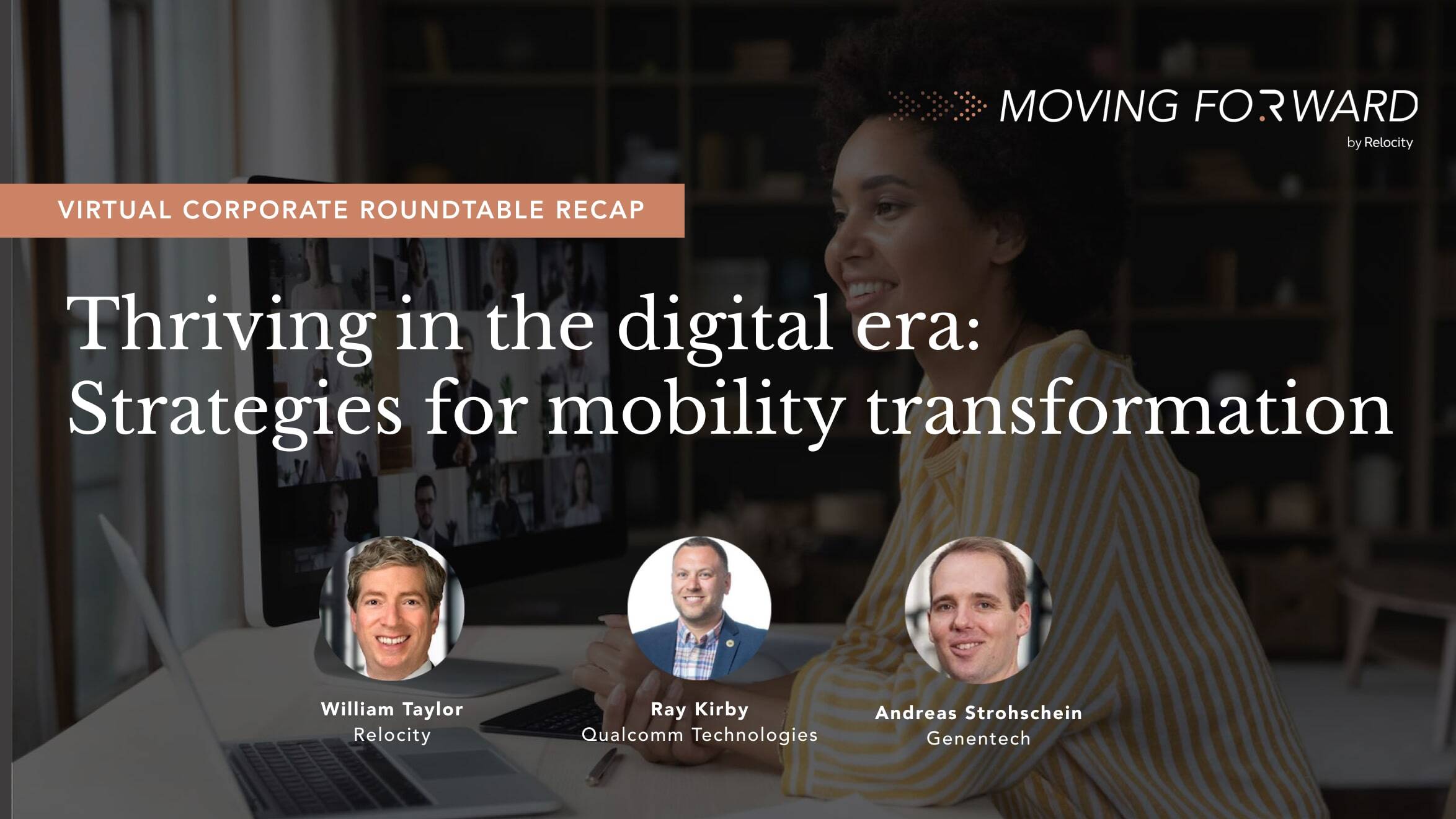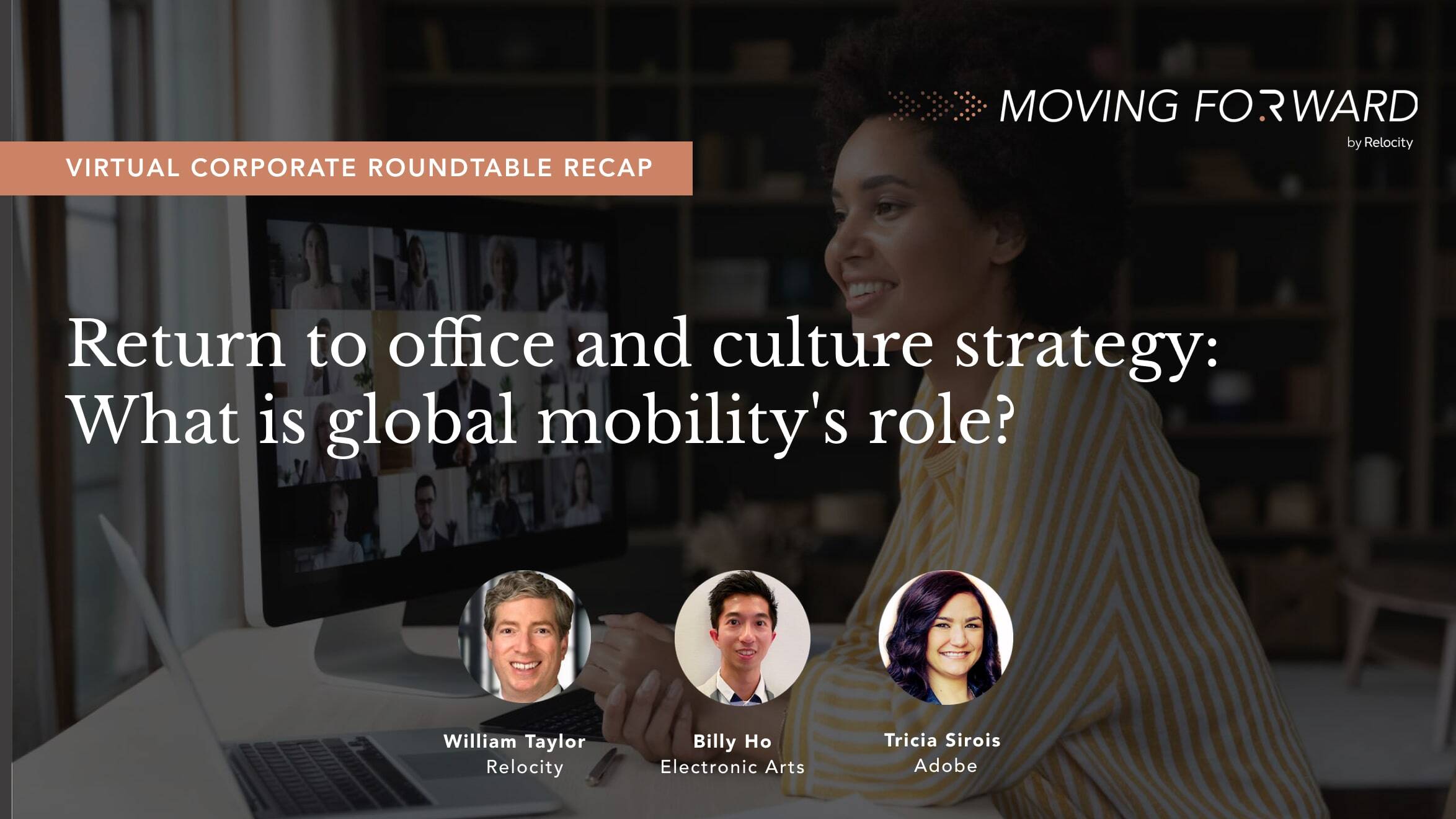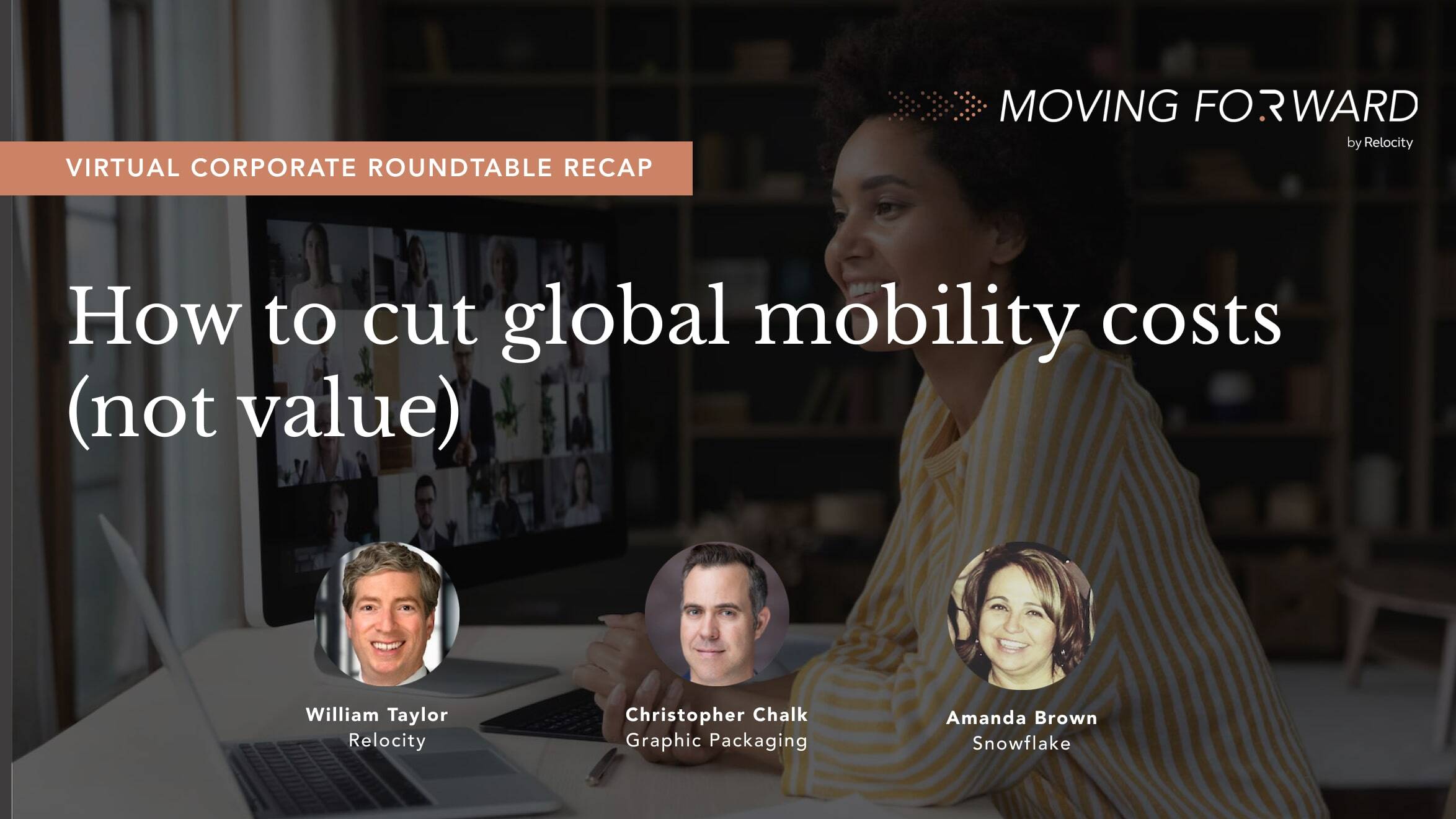[Recap] Relocity’s roundtable on ESG | Relocity
Relocity recently hosted our third virtual event as part of our corporate roundtable series: Moving Forward. These corporate roundtables bring...

At Relocity’s latest corporate roundtable in the Moving Forward series on June 11, key industry leaders discussed technology's impact on relocation. Andreas Strohschein, Senior Director of Enterprise Reward Partner Mobility at Genentech, and Ray Kirby, Senior Manager of Global Mobility at Qualcomm Technologies, joined William Taylor, Relocity’s Senior VP of Partnerships and Moving Forward host, to explore how technology can support policy design and decision-making, streamline relocation processes, and improve the mobile employee experience.
Read on for insights into:
• Unifying the end-to-end relocation journey for employees.
• Digitizing everyday HR and mobility processes.
• Streamlining mobility with automation, data consolidation, and real-time insights.
Kirby kicked off the conversation by making the point that global mobility professionals can’t elevate their function through spreadsheets. Global mobility leaders must get out of their comfort zones to radically transform global mobility operations and drive success at the team and organization levels. He has focused on increasing efficiencies, improving employee experiences, and visualizing data so that he can elevate the mobility program’s brand internally and demonstrate the value of talent mobility to the business by showcasing data-driven success stories and key metrics such as cost savings, employee satisfaction, and retention rates.
He advised the group that leveraging data and consolidating, automating, and gaining real-time insights are impactful steps to take. Additionally, if the goals are to tell data-driven stories and make strategic program decisions, global mobility leaders should build out their business requirements and determine which systems to use.
Strohschein jumped in and noted that Genentech embarked on the journey of digital transformation about two years ago as part of a broader people and culture transformation. Their transformation has streamlined processes and unified systems access. He discussed a new case management system that routes tasks, processes, and workflows and serves as a channel for transferees and other internal stakeholders to contact his team. Beyond that, Strohschein has also implemented an assignment management platform that helps Genentech run internal processes, such as cost estimates.
Kirby emphasized taking advantage of the technology and other resources that global mobility leaders already have access to. He and his team asked themselves, “What's within our HR ecosystem? What technology do our vendors already have access to?” For example, Kirby’s immigration provider has a live messaging service. Using this technology-enabled service reduces their emails and helps them answer mobile employee questions faster.
Kirby also mentioned the impact of developing educational videos. In the past, his team wrote long emails to mobile employees, but the feedback indicated that the information wasn’t timely, was too much, and/or was repetitive. Kirby reminded the group to be cognizant of the fact that mobile employees are trying to ramp up in their jobs while the global mobility team is sending them requests.
To solve for that pain point, Kirby leverages informative videos. For example, his team is creating videos with their immigration provider to dissect and provide information — on topics like the H-1B visa process and the EB-2 national interest waiver process — in a digestible way.
Strohschein jumped in and added that using video tools and AI-powered avatars are a great way to provide this resource to mobile employees. His team writes the scripts like they used to write the emails, syncs it with a PowerPoint in the background, and uses a third-party solution to produce the video, making the information more personalized and engaging for talent.
Strohschein also recommended, for efficiency, empowering recruiters to initiate services directly for all permanent transfers, local hires, or domestic moves — in partnership with the RMC and with quality checks and controls in place. Strohschein added that he has found points in the recruiting and onboarding processes to add mobility questions into existing forms and infrastructure to further streamline the overall talent management process.
Taylor furthered the conversation by asking how global mobility teams can consolidate all of relocation’s touch points, systems, vendors, and suppliers. Strohschein described the solution that his team implemented: Syncing HR system data (including demographic data) with the assignment platform, which is integrated via APIs with his RMC and can be used to initiate volumes. All data is shared automatically and comes back into the assignment management platform.
From there, Genentech’s business intelligence platform helps them tell stories and compare mobility data against other data sets, such as demographic data, compensation data, promotion data, and retention data. Adding the mobility data allows Strohschein to compare, contrast, tell stories, and find differences in the data.
Additionally, both guests mentioned the importance of leveraging AI to build an internal knowledge platform with access to controlled information that can be used for knowledge articles and educational purposes.
Taylor added that Relocity One is a way to create a unified transferee experience, with which Strohschein agreed. Strohschein shared that Relocity One shows mobile employees the specific information they need via a white-labeled platform and allows global mobility teams to own the experience and optimize it to their best interest.
Kirby offered the following advice around partnerships: Global mobility leaders should assess their needs and look at whether their providers can streamline their processes and create great user interface experiences using cutting-edge technology. For example, he said, Relocity utilizes great technology that has really enhanced his organization’s mobile employee experience. Kirby added that you may think that kicking off digital transformation will be a big undertaking, but there are great solutions out there to help you get started very quickly and easily.
In conclusion, the roundtable brought to light the fact that mobile employees want self-service. More specifically, they want on-demand answers, access to information, faster responses from their consultants, more insights into how much they’re spending on their relocation benefits, faster options for housing, visibility into the location of their household goods, and more. They want, in essence, transparency. Digital transformation lends itself to full transparency, and full transparency lends itself to increased self-service.
To listen to the full roundtable recording along with the best-in-class solutions that Kirby and Strohschein are using as part of their digital transformation, tune in here. In our next virtual corporate roundtable in August 2024, we’ll be diving into how to align intern talent strategies with today’s evolving workforce trends. Be on the lookout for an invitation or check out our Events page to register.
Want a closer look at how you can easily start digitally transforming your mobility program? Let’s chat!
![[Recap] Relocity’s roundtable on ESG | Relocity](https://www.relocity.com/hubfs/Imported_Blog_Media/64a7350ce778a81576d7ba21_RTO%20Recap%20Blog%20Main%20-%20ESG-min-1.jpg)
Relocity recently hosted our third virtual event as part of our corporate roundtable series: Moving Forward. These corporate roundtables bring...

Relocity recently hosted our first virtual event as part of our corporate roundtable series: Moving Forward. Through these corporate roundtables,...

Relocity recently hosted our second virtual event as part of our corporate roundtable series: Moving Forward. These corporate roundtables bring...